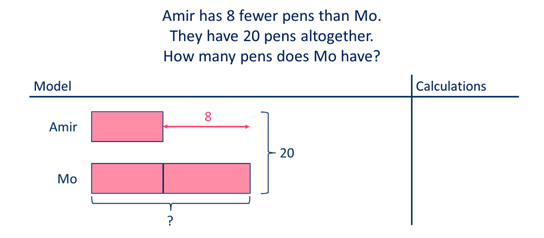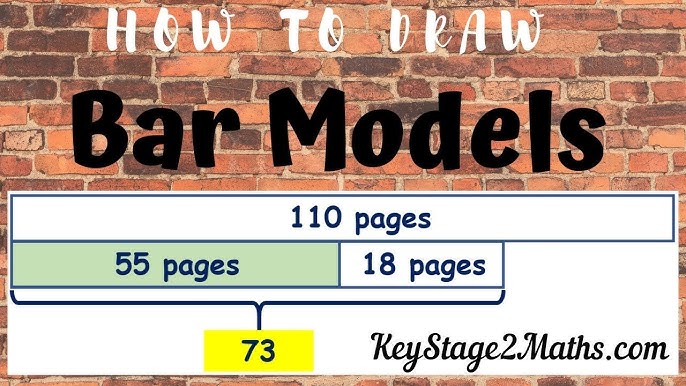The connection between visual learning and bar model drawing techniques
Exploring Bar Version Drawing Techniques: A Comprehensive Guide to Imagining Math Concepts
Bar model drawing strategies serve as an important resource for both educators and trainees in imagining mathematical ideas. These versions simplify intricate mathematical connections, aiding in the comprehension of enhancement, subtraction, multiplication, and department. This guide describes efficient techniques for implementing bar versions, promoting energetic engagement and real-world connections. As readers discover the functional applications and mentor pointers, they will reveal just how these strategies can transform their approach to mathematics.
Comprehending the Fundamentals of Bar Version Drawing
Bar model drawing works as a powerful visual tool in maths, assisting in the understanding of analytical techniques and numerical partnerships. This strategy involves representing numbers and their partnerships with rectangular bars, making it easier to imagine procedures such as addition, reduction, department, and multiplication. Each bar's size corresponds to a details value, permitting learners to contrast amounts and recognize proportions clearly.
To develop a bar design, one begins by recognizing the trouble's vital elements, commonly simplifying into parts that can be visually stood for. In an easy addition trouble, 2 bars can be drawn, with their sizes representing the addends. The mixed length highlights the sum. In addition, bar designs can be adapted for extra intricate issues, consisting of portions and proportions, by adjusting the bars accordingly. Mastering these essentials lays a solid structure for reliable problem-solving and deeper mathematical understanding.
Benefits of Using Bar Versions in Math
Using bar models in maths offers various advantages that boost learning and understanding. These aesthetic depictions aid students in realizing intricate concepts by damaging them down into convenient parts. Bar models supply a clear structure for highlighting connections between numbers, making abstract concepts more concrete. They promote a deeper understanding of mathematical operations and promote problem-solving by allowing students to picture the data they are working with.
Moreover, bar designs sustain the growth of crucial believing skills, as trainees need to assess and analyze the aesthetic details to attract verdicts. This approach encourages active interaction with the material, strengthening retention and proficiency of mathematical concepts. By fostering a strong structure in visual proficiency, bar designs equip students to come close to different mathematical difficulties with confidence. On the whole, the combination of bar models right into maths education verifies valuable in growing both comprehension and logical capabilities among students.
Using Bar Versions to Addition and Reduction
Bar versions serve as an efficient tool for aesthetically standing for enhancement and reduction troubles. By highlighting the relationship in between numbers, they enhance understanding and promote problem-solving. Furthermore, real-life applications of these models can help learners grasp mathematical ideas in sensible contexts.
Representing Addition Visually
When students encounter addition and subtraction troubles, aesthetic aids can considerably boost their understanding of these operations. Bar designs work as reliable devices for standing for enhancement. By dividing a rectangular shape right into sections that represent the numbers entailed, pupils can imagine the relationship between the amounts. As an example, if a pupil needs to include 3 and 5, they can produce a bar split right into two sections: one section standing for 3 and the various other representing 5. This clear representation not just simplifies the addition procedure however also reinforces the idea of combining amounts. As pupils control these aesthetic help, they create a much deeper comprehension of enhancement, resulting in improved analytical abilities and better self-confidence in their mathematical capabilities.
Reduction With Bar Models
Subtraction is typically regarded as a much more intricate procedure than enhancement, bar models can successfully clarify this process for students. By aesthetically representing the amounts included, pupils can better understand exactly how numbers associate to each other. In a bar version for subtraction, one bar represents the overall, while another indicates the quantity being deducted. This visual difference aids students grasp the concept of "removing." If a bar reveals 10 units, and one more bar standing for 4 systems is removed, students can conveniently see that 6 units remain. This technique not just fosters understanding of subtraction yet likewise aids in creating analytic skills, permitting trainees to imagine their mathematical thinking and improve their overall understanding of mathematical concepts.
Real-Life Application Instances
Recognizing subtraction through bar versions lays a foundation for applying these methods in real-life scenarios. In various contexts, such as budgeting or purchasing, people can envision how much cash remains after expenses. As an example, if a person has $50 and invests $20, a bar design can represent the overall quantity and the invested section, showing that $30 is left. Additionally, parents can make use of bar models to help kids understand the amount of even more things need to be added to finish a collection, such as having three apples and needing five. This aesthetic depiction streamlines intricate issues, facilitating comprehension and retention. Eventually, bar versions function as effective devices in day-to-day decision-making, improving mathematical understanding in functional scenarios.
Visualizing Reproduction and Division With Bar Models
In discovering the application of bar designs for reproduction and department, it is vital get more info to comprehend their foundational ideas. Constructing multiplication versions allows learners to visualize connections between numbers, while efficient department approaches can be illustrated with these visual help. This strategy improves understanding and analytic skills in mathematics.
Recognizing Bar Versions
Bar versions serve as a powerful visual tool for showing the principles of reproduction and department. They enable learners to represent mathematical partnerships in an organized style, promoting a much deeper understanding of these procedures. In multiplication, bar versions show groups of equal dimension, enabling people to imagine the overall quantity when integrating these teams. On the other hand, in department, bar models aid portray how an overall is separated into smaller sized, equal parts, clearing up the concept of partitioning. By utilizing these visual aids, students can understand the underlying principles of reproduction and division better. This technique not only boosts understanding yet likewise sustains problem-solving abilities, making bar versions a vital possession in mathematical education.
Building Multiplication Designs
Building reproduction designs making use of bar diagrams provides a clear approach for envisioning the process of reproduction. These versions allow students to stand for reproduction as teams of equal parts, making abstract principles a lot more concrete. As an example, to highlight (3 times 4), a student can draw one bar split into 3 equivalent sectors, each standing for four units. In addition, creating a 2nd bar with the same length reinforces the understanding of repeated enhancement, as each sector represents one group. This graph not only aids in grasping multiplication but also boosts analytic abilities. By using bar versions, students can much better comprehend partnerships between numbers and establish a durable foundation for much more complicated mathematical principles, leading to enhanced self-confidence in their abilities.
Picturing Division Methods

Addressing Word Problems Using Bar Design Techniques

For example, in an issue including enhancement and reduction, trainees can draw different bars for each and every amount and afterwards adjust them to discover the service. This procedure not just clears up the problem yet additionally promotes a deeper theoretical understanding. In addition, bar models can be adapted for numerous kinds of word problems, making them versatile across various mathematical topics. Eventually, using bar models can greatly enhance trainees' analytic abilities by providing a clear visual path to come to the appropriate solution.
Integrating Bar Designs in Various Mathematics Topics
Bar designs can be seamlessly incorporated into numerous math subjects, boosting students' understanding of concepts past standard arithmetic. In algebra, these aesthetic tools help in representing inequalities and equations, allowing students to envision partnerships in between variables. When dealing with geometry, bar versions can highlight the residential or commercial properties of shapes and spatial thinking, assisting students comprehend concepts like location and border effectively. In stats, bar designs facilitate the analysis of data collections, allowing students to contrast quantities and acknowledge patterns aesthetically. In addition, incorporating bar designs within dimension subjects aids in understanding systems and conversions by supplying a tangible representation of amounts. By using bar versions across various mathematical areas, teachers can cultivate a deeper comprehension of complicated concepts, therefore enhancing problem-solving skills and promoting critical thinking (bar model drawing techniques). This flexibility demonstrates the energy of bar versions as a foundational device for pupils in their mathematical journey
Tips for Training Bar Designs Properly
Integrating bar versions right into training methods requires thoughtful approaches to optimize their efficiency. Educators needs to start by introducing bar designs with straightforward, relatable instances that students can easily understand. This aids to construct self-confidence and knowledge with the idea. Gradually raising the intricacy of problems allows learners to apply their skills considerably. Furthermore, teachers ought to encourage students to produce their own bar models, promoting energetic involvement and ownership of their knowing.
Integrating collaborative activities can likewise enhance understanding, as pupils review and address troubles in groups. Constant feedback is necessary; instructors need to supply useful discourse on trainees' bar design representations to assist enhancement. Ultimately, linking bar versions to real-life scenarios strengthens their significance, helping pupils see the practical applications of their mathematical skills. By implementing these methods, instructors can effectively harness the power of bar models in their maths direction.
Often Asked Questions
Can Disallow Designs Be Utilized in Various Other Subjects Besides Math?
Bar designs can certainly be made use of in numerous subjects beyond math. They efficiently highlight ideas in scientific research, social researches, and language arts, assisting to aesthetically represent partnerships, procedures, and concepts for boosted understanding throughout disciplines.
What Age Team Is Ideal Fit for Learning Bar Models?
Bar models are best fit for youngsters ages 7 to 12, as they develop concrete thinking skills throughout this duration (bar model drawing techniques). At this age, students can successfully comprehend abstract principles through graph and problem-solving techniques
Exist Digital Equipment for Creating Bar Models?

How Can I Analyze Pupil Understanding of Bar Versions?
Evaluating pupil understanding of bar models can involve tests, empirical evaluations, and team conversations. Teachers may likewise evaluate pupils' completed versions and their capability to clarify their thinking, making sure a comprehensive analysis of understanding.
What Prevail Errors When Using Bar Models?
Common errors when using bar versions include misstating quantities, falling short to properly identify bars, confusing addition and subtraction, overlooking to use regular ranges, and overlooking the value of clear aesthetic splitting up in between various aspects.
In addition, bar models can be adjusted for much more intricate problems, including portions and proportions, by readjusting the bars appropriately. Subtraction is frequently perceived as a more complicated operation than enhancement, bar models can properly clarify this procedure for pupils. In a bar model for reduction, one bar represents the total, while an additional shows the amount being deducted. If a bar reveals 10 units, and an additional bar standing for 4 systems is removed, students can quickly see that 6 systems stay. When splitting an overall right into equal groups, pupils can draw a long bar to stand for the entire and then sector it right into smaller bars that show each group.